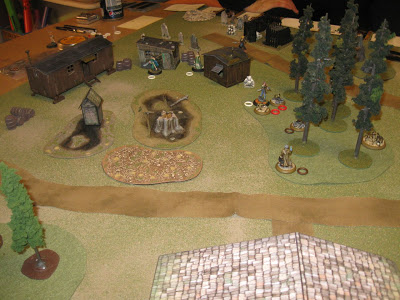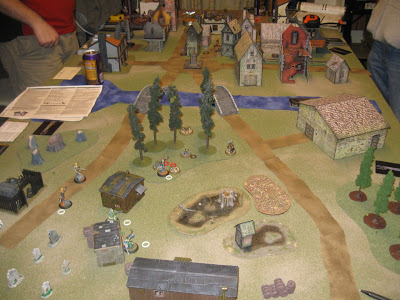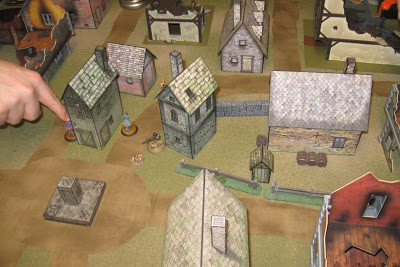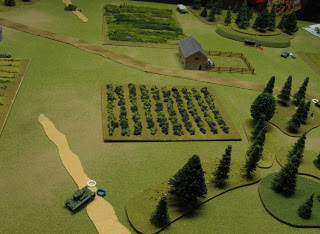I started painting and modeling for Blood & Plunder in mid-2022. I recently finished rigging a Brigantine as well as a few boats, and took pictures to share my process for sewing sails. This method requires a simple sewing machine and minimal sewing experience.

Tools and Materials
I use thin cotton fabric for my sails. I look for a thin, natural colored cotton muslin at the fabric store. When sewing the sails, I use ordinary white or natural colored sewing thread. When rigging I use a thicker upholstery thread and tan colored elastic cord.
Tools:
- A sewing machine. It only needs to perform a straight stitch, but you’ll have a much easier time if the machine can sew slowly and/or has a hand wheel to advance the needle manually as needed.
- Scissors. Don’t underestimate the importance of sharp scissors for use when sewing. Cutting fabric should feel like cutting paper, not like chewing jerky. Most folks who sew regularly dedicate a pair of scissors for use only to cut fabric, to reduce the need for sharpening.
- An iron. Although it is possible to do without an iron and to use sewing pins instead, you will have a much better time using a clothes iron to prepare your hems. In some locations, both irons and sewing machines are commonly available inexpensively at thrift stores and/or estate sales.
- Water spray bottle. In a pinch you can use a bowl and your hands; you just need to be able to get the fabric damp in a predictable way.
- Pencil and paper.
Making Sails
In order to make sails, you first need a paper pattern for each sail shape you will be making. You can download sail templates from the Firelock Games DLC site, but beware that these templates often do not perfectly match the assembled rigging. I recommend using paper to fiddle with the exact shape of the sail required, based on your (partially) assembled rigging. Once you have the sail shape correct, you can trace the paper’s shape onto cloth to make a cloth sail.

I iron the fabric before tracing patterns, to make sure it’s flat and wrinkle-free. When tracing the paper patterns onto the cloth, the direction of the pattern in relation to the cloth is important. Cloth has long straight fibers going the length of the cloth (the warp) and looser, slightly more stretchy fibers going across the warp (the weft); but it’s stretchiest along the diagonal. In order to make your sails look “billowed” correctly, especially if you’ll be using sizing (glue) to curve them, you will want to make sure that the seam lines shown on the sail pattern are parallel to the warp (length) of the fabric. When designing your own sails, typically the seam lines go vertically on square sails, or parallel to the longest side on non-square sails.
Trace around each pattern using a pencil, leaving at least 3/8″ extra cloth on each side, or more between two pieces. This is a folding line, not a cutting line! You need extra cloth outside the line to hem each edge, so cut at least 3/8″ from the line.

The next step is to prepare the edges of the sails for sewing. For this, we first fold over the corners and iron them, and then fold over each side and iron it. The objective is to get the pencil line on the outside of the fold once you’re finished ironing. It may not be perfect the first time, but the closer you are, the closer you’ll be to the right size.


When working with sails with sharp corners such as Lateen or Gaff sails, you may end up with the side fabric overlapping where the next side needs to fold on the corner. I recommend trimming away any overlapping cloth, as long as you don’t cut into the bottom layer or the corner itself. You may also need to trim the second fold before cutting to avoid sewing down too many layers. I usually start on the pointy corner so I pay attention to it.

Next is the fun part: sewing!
Here, the overall objective is to sew a line around the edge of each sail to secure the edge, and then to sew decorative “seam” lines along the length of the sail. These lines represent the seams between pieces of sailcloth on an actual sail. Sails are wider than a single bold of cloth, so many pieces of cloth must be sewn together to form a sail. Those seams are typically less stretchy than the rest of the sail, which affects the way the sail looks when it is billowed. Luckily for us, a decorative straight stitch at the proper tension is also less stretchy than the cloth, which helps the sail billow more realistically.

Start sewing on one corner, using a straight stitch, very close to the edge. I use a tight stitch, maybe 2-3 mm long. I usually lock the threads on the end by making 2 stitches, reversing for 2 stitches, and then stitching forward until the next corner. To sew a perfect tight corner: go slowly or manually until you reach the corner with the needle in the fabric exactly where you want the corner. Then stop sewing, lift the presser foot, turn the fabric to align it with the new sewing direction, and start sewing the new edge.
When you get to the end, lock the thread with 2 more stitches and trim the excess thread.

After sewing the edges of each sail, we need to trim the excess fabric before sewing the decorative seam lines. For this, I carefully align the part I’m cutting off on my lower scissor blade as I carefully cut as close as possible to the stitching without cutting the stitching or the lower fabric layer. The corners require extra work because they have several layers of excess fabric that must all be trimmed.

After the edges are trimmed, the sails may need a bit of ironing to make them flat again. Sewing the decorative seam lines is straightforward. I lock the threads on each end here as well. I mark the location of each line, to make sure they’re spaced correctly, and I use the decorative trim on the front of my sewing machine to keep the fabric aligned. A sticky ruler or marker lines on your machine would work at least as well.
Everything Else
This article is about the sewing… sorry no pics of anything else.
I don’t typically dye or stain my sail cloth, but I do often end up with mineral stains due to ironing that help give it a weathered look… I tell myself, looking on the bright side.
For fore-aft sails, I typically leave the cloth loose, without any glue or starch to keep it in a specific shape. I tend to use tension-based rigging instead of gluing all my yards in place, so the cloth ends up as a bit of a structural component of the rigging when I’m finished.
For square sails, my current technique is to curve the sail on a rubber playground ball, using a mixture of extremely watered down white glue. I use a brush to saturate the sail with watered down glue, and to press it into a curved shape on the ball. Since cloth is stretchier in the diagonal, you’ll naturally end up with the corners ending up a it pointier and the edges curved inward. To keep the top edge of large square sails straight for mounting on the beam, I use a skewer to keep the top edge of the sail straight while the rest is curved onto the ball.













